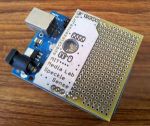SpeckleEye
Gestural Interaction for Embedded Electronics in Ubiquitous Computing
Alex Olwal
Andy Bardagjy
Jan Zizka
Ramesh Raskar

SpeckleEye describes the design and implementation of an embedded gesture and real-time motion tracking system using laser speckle. SpeckleEye is a low-cost, scalable, open source toolkit for embedded speckle sensing and gestural interaction with ubiquitous devices in the environment. We describe embedded speckle sensing hardware and firmware, a cross-platform gesture recognition library optimized to run on embedded processors, and a set of prototypes that illustrate the flexibility of our platform.
SpeckleEye Arduino Shield
|
 |
CHI 2012 Extended Abstracts
Olwal, A., Bardagjy, A., Zizka, J., and Raskar, R. SpeckleEye: Gestural Interaction for Embedded Electronics in Ubiquitous Computing. To appear in Extended abstracts of CHI 2012 (SIGCHI Conference on Human Factors in Computing Systems), Austin, TX, May 5-10, 2012.





SpeckleSense
Fast, Precise, Low-cost and Compact Motion Sensing using Laser
Speckle
Jan Zizka
Alex Olwal
Ramesh Raskar

SpeckleSense introduces a novel set of motion-sensing configurations based on laser speckle sensing that are particularly suitable for human-computer interaction.
SpeckleSense is a technique for optical motion sensing with the following properties:
- fast (10 000 fps)
- precise (50 μm)
- lensless → tiny (1 × 2 mm)
- low power
- needs minimal computation → minimal latency
SpeckleSense video (4:49)
UIST 2011 paper
Zizka, J., Olwal, A., and Raskar, R. SpeckleSense: Fast, Precise, Low-cost and Compact Motion Sensing using Laser Speckle. Proceedings of UIST 2011 (ACM Symposium on User Interface Software and Technology), Santa Barbara, CA, Oct 16-19, 2011, pp. 489-498.









Raw output from "slow" 300 fps camera (0:33)
SpeckleSense exploits the laser speckle phenomena to track small motion using fast and efficient image processing. This video illustrates how tiny movements result in dramatic changes for the speckle sensor (a 300 fps camera). To allow fast real-time interaction, we use dedicated optical sensors that are rated at thousands of fps.
TouchController = Spatial Motion + Multi-touch (0:33)
The TouchController is a hybrid input device where we combine our SpeckleSense technique with a multi-touch mouse. This allows the user to manipulate on-screen content using spatial motion, while also being able to use multi-touch gestures on its surface for rotation and zooming.
Mobile Medical Viewer with 3D Motion (0:34)
Demonstrates how SpeckleSense is used to track a mobile device in 3D above a surface. The user can pan around in a larger image by moving the device in the plane above the surface, but also view different slices in the body by varying the distance to surface.
Motion input for public displays (0:16)
We enable natural interaction in public displays by using an integrated speckle sensor and laser behind a glass window. The user's hand reflects speckles that are captured by the speckle sensor. This video shows how a user controls shown images in an image viewer by moving the hand.